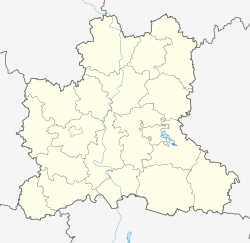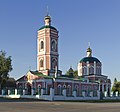Dankow
| city
Dankow
Данков
|
||||||||||||||||||||||||||||||||||||||||
|
||||||||||||||||||||||||||||||||||||||||
|
||||||||||||||||||||||||||||||||||||||||
| List of cities in Russia | ||||||||||||||||||||||||||||||||||||||||
Dankow ( Russian Данко́в ) is a city in Russia with 21,064 inhabitants (as of October 14, 2010). It lies on the upper reaches of the Don and is the district center within the Lipetsk Oblast . The city is located 86 km northwest of the regional capital Lipetsk .
history
The place was established in 1568 on the site of an old town called Donkow , which belonged to the Ryazan principality and was devastated by the Tatars a few centuries earlier . Since Dankow was on the southern borders of Russia at that time, it was initially intended as a border post. With the expansion of the empire in the 17th century, however, the place lost its importance and for a long time was a poor provincial settlement, mainly living on agriculture. It was not until the territorial reform at the end of the 18th century that Dankow received town status in 1778. After a major fire in 1791, large parts of the city were rebuilt, with several stone church buildings and merchants' houses being built.
In the 19th century, the city played a major role in the production of and trade in agricultural products, especially grain. At the end of the 19th and beginning of the 20th centuries there were also several smaller industrial companies in the city. In 1890 Dankow was connected to the Russian railway network.
After the October Revolution , Dankow lost its previous importance in trade, which even led to its city status being revoked in 1924. However, after a chemical factory had been built there in 1940, Dankow's economic importance and population increased again, and on June 26, 1941 it received the status of an urban-type settlement and on February 17, 1957 again the city charter .
Population development
| year | Residents |
|---|---|
| 1897 | 9.121 |
| 1939 | 2,858 |
| 1959 | 12,703 |
| 1970 | 20,030 |
| 1979 | 23,246 |
| 1989 | 24,659 |
| 2002 | 23,249 |
| 2010 | 21,064 |
Note: census data
Economy and Transport
The most important industrial company of Dankow is the chemical factory founded in 1940, there are also smaller companies in the light and food industry in the city. Dolomite is mined in the area and processed in a factory. Otherwise mainly agriculture is practiced in Dankow Rajon .
The city has a long-distance train station with direct connections to, among others, the Paveletsky train station in Moscow .
Attractions
There is a local history museum in the city, which is housed in a former church building from 1790. Another historic church, the Vladimir Church from 1799, can be found in the village of Balownewo, ten kilometers away. 20 km east Dankows the station is Leo Tolstoy , formerly Astapovo where in 1910 the famous writer Leo Tolstoy in the house of the station master died.
sons and daughters of the town
- Alexei Lebedew (1924–1993), tuba player and composer
- Irina Rakobolskaja (1919–2016), physicist and bomber pilot
- Anatoly Solowjow (1922–2000), theater and cinema actor
Individual evidence
- ↑ a b Itogi Vserossijskoj perepisi naselenija 2010 goda. Tom 1. Čislennostʹ i razmeščenie naselenija (Results of the All-Russian Census 2010. Volume 1. Number and distribution of the population). Tables 5 , pp. 12-209; 11 , pp. 312–979 (download from the website of the Federal Service for State Statistics of the Russian Federation)
Web links
- Unofficial website (Russian)
- Dankow on mojgorod.ru (Russian)







